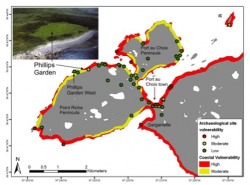Rising seas threaten coastal archaeology in Newfoundland

Our coastal archaeological heritage is potentially vulnerable to increased erosion resulting from future sea-level rise and increased storminess. As all sites cannot be protected, it is essential that heritage managers know which sites and landscapes are most at risk so they can prioritize resources and decision-making most effectively. One method of doing so is through desk-based modeling of coastal vulnerability. Our paper outlines the advantages and limitations of such an approach and demonstrates the application of a desk-based model to case studies from Newfoundland’s coast.
Of particular note, our modeling predicts that 20% of archaeological sites in our study are at risk over the next 15–50 years, and will be exposed to increased coastal erosion as sea level rises and surge activity increases. These include internationally important sites at L’Anse aux Meadows and Port au Choix that are adjacent to the modern coast and situated on low-lying topography. Though not in immediate danger, our analysis suggests that they may be threatened from 2050 onwards.
Westley, K., Bell, T., Renouf, M.A.P., and Tarasov, L., Impact Assessment of Current and Future Sea-Level Change on Coastal Archaeological Resources—Illustrated Examples From Northern Newfoundland. The Journal of Island and Coastal Archaeology, 6: 351-374.
Online link to article here.